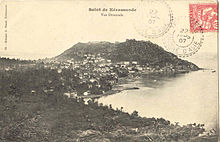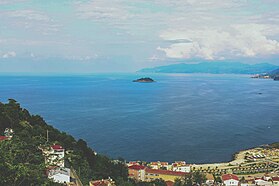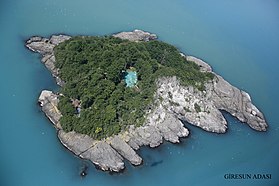Giresun
 From Wikipedia - Reading time: 21 min
From Wikipedia - Reading time: 21 min
This article's tone or style may not reflect the encyclopedic tone used on Wikipedia. (May 2021) |
Giresun | |
|---|---|
 General view of eastern part of Giresun city | |
| Coordinates: 40°54′55″N 38°23′22″E / 40.91528°N 38.38944°E | |
| Country | Turkey |
| Province | Giresun |
| District | Giresun |
| Government | |
| • Mayor | Fuat Köse (CHP) |
| Elevation | 50 m (160 ft) |
| Population (2022)[1] | 125,682 |
| Time zone | UTC+3 (TRT) |
| Postal code | 28610 |
| Area code | 0454 |
| Climate | Cfa |
| Website | www |
Giresun (pronounced [ɟiˈɾesun]), formerly Cerasus (Ancient Greek: Κερασοῦς, Greek: Κερασούντα), is a city in the Black Sea Region of northeastern Turkey, about 175 km (109 mi) west of the city of Trabzon. It is the seat of Giresun Province and Giresun District.[2] It has a population of 125,682 (2022).[1]
Etymology
[edit]Giresun was known to the ancient Greeks as Choerades or more prominently as Kerasous or Cerasus (Ancient Greek: Κερασοῦς), the origin of the modern name.
The name Kerasous consists of the Greek words κερασός (kerasós) "cherry" + -ουντ (a place marker).[3] Thus, the Greek root of the word "cherry", κερασός (kerasós), predates the name of the city,[3] and the ultimate origin of the word cherry (and thus the name of the city) is probably from a Pre-Greek substrate, likely of Anatolian origin, given the intervocalic σ in Κερασοῦς and the apparent cognates of it found in other languages of the region.[3] According to Pliny, the cherry was first exported from Cerasus to Europe in Roman times by Lucullus.[4]
Another theory suggests that Kerasous comes from κέρας (keras) "horn" + -ουντ (a place marker), due to the prominent horn-shaped peninsula that the city is situated on (compare with the Greek name for the horn-shaped Golden Horn waterway in Istanbul, Κέρας (Keras) "Horn").[5] The toponym would have later mutated into Kerasunt (sometimes written Kérasounde or Kerassunde), and the word "cherry" (as well as its cognates found in other local languages) was derived from the name of the city itself, rather than the other way around.[5]
Pharnaces I of Pontus renamed the city Pharnacia after himself after he captured the city in 183 BC, and it was called by that name as late as the 2nd century AD. According to A. H. M. Jones, the city officially reverted to its original name, Kerasous, in 64 AD.[6]
The Greek name Kerasous was Turkified into Giresun (Ottoman Turkish: گیرهسون) after Turks gained permanent control of the region in the late 14th century.
Geography
[edit]
The surrounding region has rich agriculture, growing most of Turkey's hazelnuts as well as walnuts, cherries, leather and timber, and the port of Giresun has long handled these products. The harbor was enlarged in the 1960s, and the town is still a port and commercial center for the surrounding districts.
Like everywhere else on the Black Sea coast, it rains (and often snows in winter) and is very humid throughout the year, with a lack of extreme temperatures both in summer and winter. As a result, Giresun and the surrounding countryside are covered with luxuriant flora. Just beyond the city are hazelnut groves, and there are high pastures (yayla) further in the mountains.
Climate
[edit]Giresun has a humid subtropical climate (Cfa or Cf) under both the Köppen and Trewartha climate classifications, with warm, humid summers and cool, damp winters. As a part of the very humid southern Black Sea coast, it experiences frequent precipitation throughout the year, with a small peak in rainfall days in spring and fall. Giresun is the cloudiest city in Turkey, as well as one of the cloudiest cities of the temperate latitudes; with annual sunshine of around 1,000 hours, it is more akin to far northwestern Europe.
Snowfall is somewhat common between the months of December and March, snowing for a week or two, and it can be heavy once it snows.
The water temperature is cool in winter and warm in summer and fluctuates between 8 °C (46 °F) and 24 °C (75 °F) throughout the year.
| Climate data for Giresun (1991–2020, extremes 1929–2020) | |||||||||||||
|---|---|---|---|---|---|---|---|---|---|---|---|---|---|
| Month | Jan | Feb | Mar | Apr | May | Jun | Jul | Aug | Sep | Oct | Nov | Dec | Year |
| Record high °C (°F) | 29.1 (84.4) |
29.5 (85.1) |
34.9 (94.8) |
36.0 (96.8) |
35.4 (95.7) |
36.2 (97.2) |
35.3 (95.5) |
35.2 (95.4) |
32.9 (91.2) |
37.3 (99.1) |
32.8 (91.0) |
28.0 (82.4) |
37.3 (99.1) |
| Mean daily maximum °C (°F) | 10.6 (51.1) |
10.7 (51.3) |
12.4 (54.3) |
15.3 (59.5) |
19.2 (66.6) |
23.9 (75.0) |
26.8 (80.2) |
27.4 (81.3) |
24.2 (75.6) |
20.3 (68.5) |
16.0 (60.8) |
12.7 (54.9) |
18.3 (64.9) |
| Daily mean °C (°F) | 7.6 (45.7) |
7.4 (45.3) |
8.8 (47.8) |
11.6 (52.9) |
16.0 (60.8) |
20.8 (69.4) |
23.7 (74.7) |
24.3 (75.7) |
21.0 (69.8) |
17.2 (63.0) |
12.8 (55.0) |
9.7 (49.5) |
15.1 (59.2) |
| Mean daily minimum °C (°F) | 5.3 (41.5) |
4.8 (40.6) |
6.1 (43.0) |
8.9 (48.0) |
13.6 (56.5) |
18.1 (64.6) |
21.0 (69.8) |
21.7 (71.1) |
18.4 (65.1) |
14.7 (58.5) |
10.3 (50.5) |
7.3 (45.1) |
12.5 (54.5) |
| Record low °C (°F) | −6.2 (20.8) |
−9.8 (14.4) |
−5.8 (21.6) |
−1.4 (29.5) |
4.0 (39.2) |
6.8 (44.2) |
12.1 (53.8) |
12.1 (53.8) |
4.8 (40.6) |
4.2 (39.6) |
−1.6 (29.1) |
−2.4 (27.7) |
−9.8 (14.4) |
| Average precipitation mm (inches) | 127.6 (5.02) |
92.0 (3.62) |
98.0 (3.86) |
72.8 (2.87) |
73.1 (2.88) |
83.9 (3.30) |
82.2 (3.24) |
81.8 (3.22) |
133.7 (5.26) |
175.8 (6.92) |
158.5 (6.24) |
129.0 (5.08) |
1,308.4 (51.51) |
| Average precipitation days | 14.57 | 13.67 | 16.33 | 15.07 | 14.57 | 12.57 | 10.63 | 11.43 | 12.73 | 15.40 | 12.67 | 14.67 | 164.3 |
| Average relative humidity (%) | 66.7 | 67.3 | 69.8 | 73.8 | 76.1 | 73.8 | 73 | 72.5 | 72.7 | 73.1 | 67 | 65.1 | 70.9 |
| Mean monthly sunshine hours | 52.7 | 70.6 | 65.1 | 87.0 | 108.5 | 141.0 | 124.0 | 108.5 | 87.0 | 62.0 | 75.0 | 49.6 | 1,031 |
| Mean daily sunshine hours | 1.7 | 2.5 | 2.1 | 2.9 | 3.5 | 4.7 | 4.0 | 3.5 | 2.9 | 2.0 | 2.5 | 1.6 | 2.8 |
| Source 1: Turkish State Meteorological Service (sun 1929–2020)[7][8][9] | |||||||||||||
| Source 2: NOAA NCEI(Humidity)[10] | |||||||||||||
History
[edit]



Giresun was founded circa 180 BC by Pharnaces I of Pontus, who sent Greek citizens from Kotyora (modern Ordu) to colonize the area.[11] The name of the city was first cited in the book Anabasis by Xenophon as Kerasus. Historic records reveal that the city was dominated by the Miletians, Persians, Romans, Byzantines and the Empire of Trebizond. The older parts of the city lie on a peninsula crowned by a ruined Byzantine fortress, sheltering the small natural harbor. Nearby is Giresun Island, called Aretias in ancient times, which is the only major Black Sea island in Turkish territory. According to legend, the island was sacred to the Amazons, who had dedicated a temple to the war god Ares here. Even today, fertility rites are performed there every May, usually involving the famed boulder named the Hamza Stone on the east side of the island, now shrouded as a popular practice but in reality a 4,000-year-old celebration.
Cerasus in late antiquity became a Christian bishopric, and the names of several of its bishops are preserved in the acts of church councils: Gregorius at the Council of Ephesus in 431, Gratianus at the Council of Chalcedon in 451, Theophylactus at the Third Council of Constantinople in 680, Narses at the Trullan Council in 692, Ioannes at the Second Council of Nicaea in 787, and Simeon at the Photian Council of Constantinople in 879. An episcopal seal records a Leo of the 9th century, and a Michael was transferred from here to the see of Ancyra at the time of Michael Caerularius.[12][13][14] It was the seat of a Greek Orthodox metropolitan until 1703, when the city was placed under the metropolitan of Trebizond.[15] Accordingly, it is today listed by the Catholic Church as a titular see.[16] The Ecumenical Patriarchate of Constantinople also considers Cerasus (Kerasous), together with Chaldia and Cheriana, as a titular metropolitanate in Turkey.
During the medieval period, Kerasunt was part of the Byzantine Empire and later the second city of the Empire of Trebizond ruled by the Komnenian dynasty. Alexios II Komnenos, Emperor of Trebizond, defeated the Turkmen "Koustoganes" at Kerasunt in September 1302; to secure his victory, Alexios II built a fortress which overlooks the sea.[17] From 1244 onwards, the Seljuk Turks moved into the area, pursued at times by the Mongol hordes until in 1461, subsequent to the Fall of Constantinople, the whole of this coast was brought within the Ottoman Empire by Sultan Mehmed II. It was briefly occupied by Emirate of Hacıemiroğlu (Emirate of Chalybia) between 1398 and 1400. Local traditions claim that Kerasunt held out for many months after the fall of Trebizon in 1461, then surrendered on terms that the Christian inhabitants could remain and retain their arms, but were required to maintain a boat for the use of the Turks on a nearby river.[18]
4.2 km east-northeast of Kerasus is a fortified island called Ares (Αρητιας νήσος or Αρεώνησος). According to the poetic account of Apollonius of Rhodes, it was here that the Argonauts encountered both the Amazons and a flock of vicious birds. The Greeks of the island held out against the Ottomans for 7 years after the fall of Trebizond (modern Trabzon) in 1461.
Kerasounta became known by its Turkish name Giresun after 1923.
Demographics
[edit]Surviving Greeks fled to Greece after the 1923 Population Exchange founding villages such as Nea Kerasounta in Preveza, Greece.
Economy
[edit]
Historically, Giresun was known for producing hazelnut. As of 1920, hazelnuts covered 460 square miles of the area. [19] Manganese mines were also in the area, producing 470 tons as of 1901.[20]
Sports
[edit]The city owns a football team Giresunspor and a football stadium Çotanak Sport Complex.
Alperen Şengün (25 July 2002) a professional basketball player for the Houston Rockets of the National Basketball Association (NBA) was born in Giresun.
Places of interest
[edit]- The well preserved Giresun Castle in the city center
- Giresun Island
- Museum, Children's Library, Hacı Hüseyin Mosque, Kale Mosque, Seyyid-i Vakkas Tomb, Mausoleum of Topal Osman
- Giresun Archaeological Museum (the former Gorgora church)
- Old Ottoman houses of Zeytinlik district
- Kırkharman Kilisesi, a former Greek church
- Highlands (Kümbet, Bektaş, Kulakkaya, Çakrak, Tohumluk, Kurtbeli, Kazıkbeli, Ayıbeli, Beytarla, Buları, Kırkharman)
- Kuzalan Falls and Blue Lake
- Duroğlu
- Giresun places of interest
-
Old Ottoman houses in Zeytinlik neighbourhood
-
Belltower of St. Nicholas church, Kerasus (Giresun)
-
Giresun Archaeological Museum, formerly known as Gogora church
-
Giresun and its island
-
The island of Giresun
Notable people
[edit]- Ashot Zorian (1905–1970), Turkish-born Egyptian painter and educator, of Armenian ethnicity[21]
- Alperen Şengün (2002), Turkish basketball player
International relations
[edit]Twin towns - sister cities
[edit] Alba, Italy
Alba, Italy Bátonyterenye, Hungary
Bátonyterenye, Hungary La Louvière, Belgium
La Louvière, Belgium Ölgii, Mongolia
Ölgii, Mongolia Sagae, Japan
Sagae, Japan Shaki, Azerbaijan
Shaki, Azerbaijan Urmia, Iran
Urmia, Iran
References
[edit]- ^ a b "Address-based population registration system (ADNKS) results dated 31 December 2022, Favorite Reports" (XLS). TÜİK. Retrieved 13 March 2023.
- ^ İl Belediyesi, Turkey Civil Administration Departments Inventory. Retrieved 1 March 2023.
- ^ a b c Robert S. P. Beekes (2010). Etymological Dictionary of Greek. Brill. ISBN 978-90-04-17418-4.
As the improved cherry came from the Pontos area (cf. Κερασοῦς "rich in cherries", town on the Pontos), the name is probably Anatolian as well. Given its intervocalic σ, the form must be Anatolian or Pre-Greek. For the suffix, cf. ▶-θíασος, ▶-κάρπασος, which too are of foreign origin. Assyr. karšu has also been adduced. Cf. on ▶κράνον 'cornelian cherry'. Gr. κέρασος, -íα, κεράσιον were borrowed into many languages: Asiatic names of the cherry-tree and the cherry, like Arm. ker̄as, Kurd. ghilas, and in the West, Lat. cerasus, -ium, VLat. ★cerasia, ★ceresia, -ea; from Latin came the Romance and Germanic forms like MoFr. cerise, OHG chirsa > Kirsche. Lit.: Olck in PW 11: 509f. and Hester Lingua 13 (1965): 356.
- ^ Pliny the Elder. "Olives, olive-oil and fruit-trees". Natural History 15.30. Archived from the original on 2017-01-01.
Before the victory of Lucius Lucullus in the war against Mithridates, that is down to 74 BC, there were no cherry-trees in Italy. Lucullus first imported them from Pontus...
- ^ a b Özhan Öztürk (2005). Karadeniz: Ansiklopedik Sözlük [Black Sea: Encyclopedic Dictionary]. Istanbul: Heyamola Publishing. ISBN 975-6121-00-9. Archived from the original on 2008-05-13.
- ^ Arrian: Periplus Ponti Euxini, edited and translated by Aidan Liddle (London: Bristol Classical Press, 2003), p. 117
- ^ "Resmi İstatistikler: İllerimize Ait Mevism Normalleri (1991–2020)" (in Turkish). Turkish State Meteorological Service. Retrieved 24 April 2021.
- ^ "Resmi İstatistikler: İllerimize Ait Genel İstatistik Verileri" (in Turkish). Turkish State Meteorological Service. Retrieved 24 April 2021.
- ^ @yturker (14 January 2021). "1⃣ Yaptığım incelemelere göre, 12..." (Tweet) – via Twitter.
- ^ "World Meteorological Organization Climate Normals for 1991-2020: Turkiye-Giresun" (CSV). NOAA. Retrieved 2023-12-29.
- ^ The Princeton Encyclopedia of Classical Sites, PHARNAKEIA KERASOUS (Giresun) Pontus, Turkey
- ^ Michel Lequien, Oriens christianus in quatuor Patriarchatus digestus, Paris 1740, Vol. I, coll. 513-516
- ^ Raymond Janin, v. Cérasonte, in Dictionnaire d'Histoire et de Géographie ecclésiastiques, vol. XII, Paris 1953, coll. 154-155
- ^ Pius Bonifacius Gams, Series episcoporum Ecclesiae Catholicae, Leipzig 1931, p. 442
- ^ Speros Vryonis Jr., The Decline of medieval Hellenism in Asia Minor: and the process of Islamization from the eleventh through the fifteenth century, (Berkeley: University of California, 1971), p. 449 n. 13
- ^ Annuario Pontificio 2013 (Libreria Editrice Vaticana 2013 ISBN 978-88-209-9070-1), p. 866
- ^ William Miller, Trebizond: The last Greek Empire of the Byzantine Era: 1204-1461, 1926 (Chicago: Argonaut, 1969), p. 33
- ^ Miller, Trebizond, p. 107
- ^ Prothero, W.G. (1920). Armenia and Kurdistan. London: H.M. Stationery Office. p. 61.
- ^ Prothero, W.G. (1920). Armenia and Kurdistan. London: H.M. Stationery Office. p. 73.
- ^ Yan, Nair (2016-10-27). "Ashod Zorian Paintings Donated to the Armenian National Gallery". The Armenian Mirror-Spectator. Retrieved 2023-02-02.
- ^ "Kardeş Şehirler". giresun.bel.tr (in Turkish). Giresun. Retrieved 2020-01-18.
- The Byzantine Monuments and Topography of the Pontos by A. Bryer and D. Winfield
- The Encyclopaedia of Pontian Hellenism.
 KSF
KSF




